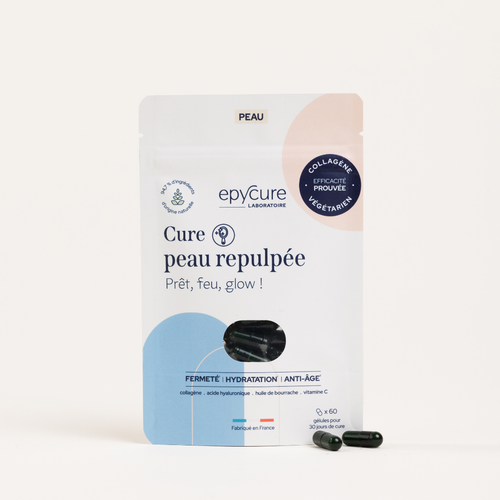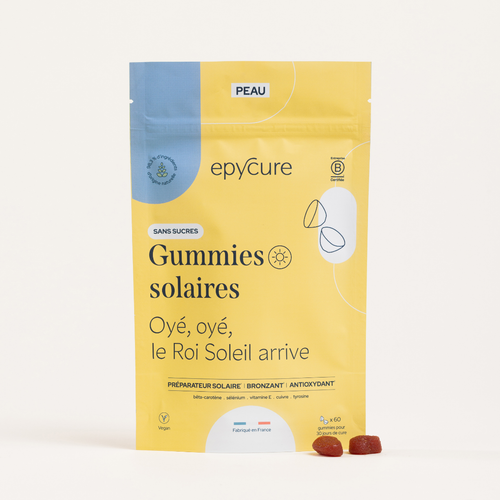The skin is the largest organ in our body and often reflects our inner health . Like the liver, kidneys, lungs and intestines, it fulfills various vital functions : barrier, photoprotection and metabolism.
It is made up of three layers : the epidermis, the dermis and the hypodermis. It is the epidermis that plays the role of protection because thanks to the sebum that covers it, it protects the body from external aggressions. The dermis , for its part, is composed mainly of water , collagen fibers and elastin , responsible for the firmness and elasticity of the skin . Finally, the hypodermis , the deepest part which can represent up to 30% of our body weight, is responsible for the flexibility of the skin .
Skin aging , dull complexion , dehydration , spots , the skin is subjected to many daily attacks. For healthy skin, it is best to avoid as much as possible the overload of harmful substances found in certain cosmetics (makeup, cream, makeup remover, etc.) and in food (ultra-processed foods, alcohol, sugars, fats, etc.).
What foods for healthy skin?
Certain nutrients help maintain healthy skin by stimulating cell renewal , collagen production or by neutralizing free radicals responsible for its destruction.
Vitamin C
It is found in very large quantities in the skin . Essential for the formation of collagen for the elasticity and firmness of the skin , this powerful antioxidant also neutralizes toxins present in pollutants or following exposure to UV rays in order to limit their impact on the skin.
It also modulates the synthesis of melanin which, without regulation, would cause hyperpigmentation which causes age spots .
Where can you find it? Some of the foods richest in vitamin C include citrus fruits, blackcurrants, kiwi, guava, red berries, parsley, peppers, and any type of cabbage.
Zinc
It helps protect and defend the skin by blocking UV rays , promoting healing and roughness of the skin. Thanks to its action on the sebaceous glands , zinc also plays an important role in skin imperfections to limit the appearance of acne or inflammatory diseases such as psoriasis. More generally, it helps maintain healthy hair and nails .
Where is it found? Zinc is found in animal proteins: meat, fish, seafood, and eggs, and in plant proteins: shiitake, basil, cashew nuts, etc. Note, however, that the latter are less bioavailable, so vegetarians and vegans should be aware of deficiencies!
Omega 3
These are essential and anti-inflammatory fatty acids , which fight against acne , redness and eczema . They are associated with healthy skin aging by keeping it firm, thick and well hydrated while fighting the cutaneous impact of UV rays to prevent the appearance of melanoma and carcinoma .
Where can we find them? Foods rich in omega-3s include chia seeds, vegetable oils (flax, rapeseed, walnuts, soybeans), and oily fish (salmon, tuna, mackerel, which should be eaten at least once a week).
Polyphenols
Multifaceted ingredients, they range from anti-inflammatory , moisturizing , smoothing , anti-aging , photoprotective and even antioxidant properties. They are widely used in cosmetics because they also have depigmenting properties , which are useful for the signs of aging, and stimulate the production of collagen and elastin for hydrated and plumped skin!
Where are they found? They are mainly found in fruits and vegetables: strawberries, lychees, grapes, apricots, artichokes, parsley, broccoli, Brussels sprouts, etc. They are also found in coffee, cocoa, and even red wine, but in moderation ;)
Beta-carotene
Highly valued for its action on tanning , particularly in food supplements, beta-carotene is also known for its antioxidant power. It is found in the sebaceous glands which helps protect the skin from UV rays, this is called “ photoprotection ”. It therefore helps fight against the harmful effects of sunburn , the rapid appearance of skin aging , and therefore wrinkles . In addition to that, its orange color gives you a tanned complexion without even exposing yourself to the sun !
Where is it found? Foods rich in beta-carotene include wakame, carrots, sweet potatoes, spinach, pumpkin, and lettuce.
Without forgetting, of course, that diet isn't everything. It's important to stay well hydrated by drinking at least 1.5L of water per day , by exercising regularly and, above all, not neglecting your sleep . As a reminder, our skin is a reflection of our inner self !







